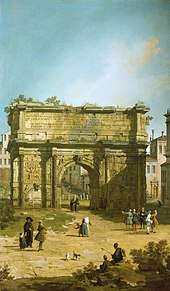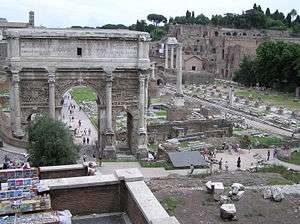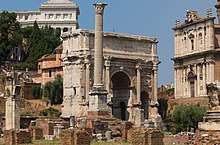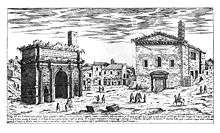Arch of Septimius Severus
The Arch of Septimius Severus (Italian: Arco di Settimio Severo) at the northwest end of the Roman Forum is a white marble triumphal arch dedicated in 203 to commemorate the Parthian victories of Emperor Septimius Severus and his two sons, Caracalla and Geta, in the two campaigns against the Parthians of 194/195 and 197–199.
| Arch of Septimius Severus | |
|---|---|
 | |
| Location | Regione VIII Forum Romanum |
| Built in | 203 AD |
| Built by/for | Septimius Severus |
| Type of structure | Triumphal arch |
| Related | List of ancient monuments in Rome |
  Arch of Septimius Severus | |

After the death of Septimius Severus, his sons Caracalla and Geta were initially joint emperors. Caracalla had Geta assassinated in 212; Geta's memorials were destroyed and all images or mentions of him were removed from public buildings and monuments. Accordingly, Geta's image and inscriptions referring to him were removed from the arch.
Description
The arch was raised on a travertine base originally approached by steps from the Forum's ancient level. The central archway, spanned by a richly coffered semicircular vault, has lateral openings to each side archway, a feature copied in many Early Modern triumphal arches. The Arch is about 23 meters in height, 25 meters in width. The arch bears two sets of reliefs. The first set includes four large panels on each face of the attic and the second set consists of eight panels that are set into the inner face of the four archways.[1]
The three archways rest on piers, in front of which are detached composite columns on pedestals. Winged Victories are carved in relief in the spandrels. A staircase in the south pier leads to the top of the monument, on which were statues of the emperor and his two sons in a four-horse chariot (quadriga), accompanied by soldiers.
 The Arch of Septimius Severus
The Arch of Septimius Severus- Lateral arched opening between the main arch and a side archway
 Part of the Roman Forum, with the Arch left and the Palatine Hill right
Part of the Roman Forum, with the Arch left and the Palatine Hill right
History
The Arch stands close to the foot of the Capitoline Hill, and a little to the east, three Corinthian pillars which are the remains of the Temple of Jupiter Tonans.[2] A flight of steps originally led to the central opening, as one still does to the Arch of Trajan at Ancona. By the 4th century, erosion had raised the level of the Forum so much that a roadway was put through the Arch for the first time. So much debris and silt eroded from the surrounding hills that the arch was embedded to the base of the columns. The damage wrought by wheeled medieval and early modern traffic can still be seen on the column bases, above the bas-reliefs of the socles.
During the Middle Ages repeated flooding of the low-lying Forum washed in so much additional sediment and debris that when Canaletto painted it in 1742, only the upper half of the Arch showed above ground. The well-preserved condition of the Arch owes a good deal to its having been incorporated into the structure of a Christian church, given 1199 by Pope Innocent III to the church of Ss. Sergio and Bacco. Half the Arch belonged to the Cimini family, who is also attributed for the preservation of the structure (Claustrum Cimini). The stronghold included a tower placed on top of the Arch itself. When the church was refounded elsewhere, the arch remained ecclesiastical property and was not demolished for other construction.
Dedicatory inscription
The dedicatory inscription on the arch reads:
IMP · CAES · LVCIO · SEPTIMIO · M · FIL · SEVERO · PIO · PERTINACI · AVG · PATRI PATRIAE PARTHICO · ARABICO · ET PARTHICO · ADIABENICO · PONTIFIC · MAXIMO · TRIBUNIC · POTEST · XI · IMP · XI · COS · III · PROCOS · ET IMP · CAES · M · AVRELIO · L · FIL · ANTONINO · AVG · PIO · FELICI · TRIBUNIC · POTEST · VI · COS · PROCOS · (P · P · OPTIMIS · FORTISSIMISQVE · PRINCIPIBUS) OB · REM · PVBLICAM · RESTITVTAM · IMPERIVMQVE · POPVLI · ROMANI · PROPAGATVM · INSIGNIBVS · VIRTVTIBVS · EORVM · DOMI · FORISQVE · S · P · Q · R
Imp(eratori) Caes(ari) Lucio Septimio M(arci) fil(io) Severo Pio Pertinaci Aug(usto) patri patriae Parthico Arabico et Parthico Adiabenico pontific(i) maximo tribunic(ia) potest(ate) XI imp(eratori) XI, co(n)s(uli) III proco(n)s(uli) et imp(eratori) Caes(ari) M(arco) Aurelio L(ucii) fil(io) Antonino Aug(usto) Pio Felici tribunic(ia) potest(ate) VI co(n)s(uli) proco(n)s(uli) (p(atri) p(atriae) optimis fortissimisque principibus) ob rem publicam restitutam imperiumque populi Romani propagatum insignibus virtutibus eorum domi forisque S(enatus) P(opulus) Q(ue) R(omanus).
In English:
"To the emperor Caesar Lucius Septimius Severus Pius Pertinax Augustus Parthicus Arabicus Parthicus Adiabenicus, son of Marcus, father of his country, Pontifex Maximus, in the eleventh year of his tribunician power, in the eleventh year of his rule, consul thrice, and proconsul, and to the emperor Caesar Marcus Aurelius Antoninus Augustus Pius Felix, son of Lucius, in the sixth year of his tribunician power, consul, and proconsul (fathers of their country, the best and bravest emperors), on account of the restored republic and the rule of the Roman people spread by their outstanding virtues at home and abroad, the Senate and the People of Rome (sc. dedicate this monument)"
Septimius Severus was ruling jointly as emperor with his son Caracalla (Marcus Aurelius Antoninus) when the arch was dedicated. The parenthesized section in the middle is text that replaced an original reference to his other son Geta, which was chiseled out upon Geta's damnatio memoriae by Caracalla.
Gallery
 The Column of Phocas with the Arch of Septimius Severus in the background
The Column of Phocas with the Arch of Septimius Severus in the background Front view of the arch
Front view of the arch The Church of Saints Luca e Martina next to the arch
The Church of Saints Luca e Martina next to the arch- View of the arch with Temple of Saturn in the background
 Arch of Septimus Severus with medieval fortification of 'Claustrum Cimini' including a tower still visible
Arch of Septimus Severus with medieval fortification of 'Claustrum Cimini' including a tower still visible.jpg) Relief of the Parthian prisoners of war
Relief of the Parthian prisoners of war
References
- Perkins, J. B. Ward (December 1951). "The Arch of Septimius Severus at Lepcis Magna". Archaeology. 4 (4): 226–231. JSTOR 41663010.
- The Congregational magazine, for the year 1834. 10. Jackson and Walford. 1834.
External links
| Wikimedia Commons has media related to Category:Arch of Septimius Severus (Rome). |
- Arch of Septimius Severus photo gallery and virtual reality movie.
- Arcus Septimii Severi, the article in Platner's Topographical Dictionary of Ancient Rome
- Arch of Severus
- Richard Brilliant, The Arch of Septimius Severus In the Roman Forum, 1963.
- Hinterhöller, Monika, "Der Triumphbogen des Septimius Severus und die historischen Reliefs der Partherkrieg", 2008, GRIN Verlag
- High-resolution 360° Panoramas and Images of Arch of Septimius Severus | Art Atlas
